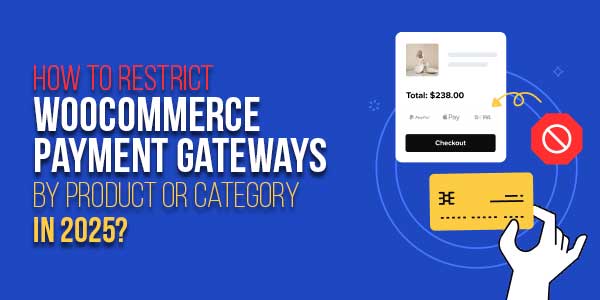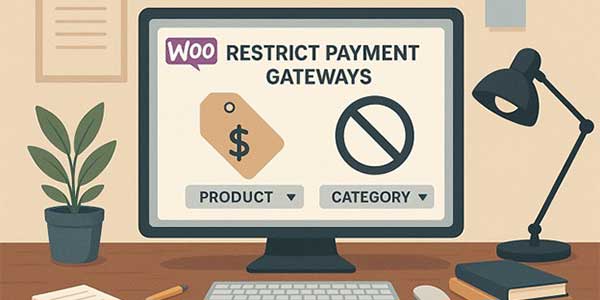
There are times when you want shoppers to see only the payment options that actually make sense for the product they are buying. Some items work fine with cash on delivery, while others need upfront payment. Some categories require card payment because of higher risk, and some virtual items cannot be purchased with certain local methods at all.
This is where store owners start digging for a way to restrict payment gateways based on conditions, and they usually end up realising that the system needs a smarter set of rules. Many users come across tools built to hide shipping rules and then discover that the same rule-based logic works really well for payments too.
A hide shipping method for the WooCommerce plugin with strong conditional features can also manage payment visibility when used correctly, which is why people use it as their solution. I have worked with stores that kept all payment methods active for every product, and then kept wondering why some orders created processing issues.
It is usually not the customer’s fault. If the checkout shows a method that should never have been available for a certain item, then they will pick it. So restricting methods based on product or category becomes a clean way to guide the customer while keeping your internal workflow safe. It takes a few rules, and then everything stays in order automatically.
The rest of this guide explains how to set those conditions, how they work, and how you can decide which payment methods appear only when needed.
Table of Contents
Why Payment Restrictions Make Sense in 2025?
The checkout behaviour of a store’s customers keeps on changing from time to time rather than staying stagnant; however, one thing always remains the same: the expectation. Your customers will always expect there to be clarity and various payment options applicable to their purchase.
If you instead prompt them with every available method, regardless of what they are buying, you are just going to make them more confused with a cluttered checkout. A WooCommerce hide shipping method style ruleset lets you filter payment gateways based on product-level conditions, and that makes your checkout clean and logical.
There are a few real-world reasons why this matters now more than ever. Digital goods often require instant payment. Fragile products might not be eligible for cash on delivery in certain regions. Some high-value items should never be paid through less secure gateways.
Even subscription-based products need special payment methods that support recurring billing. When everything is mixed without rules, it becomes messy and leads to abandoned carts or failed payments.
On top of this, many stores want to adapt their checkout depending on stock levels or seasonal conditions. For example, if you are offering same-day delivery for a quick seller, then you do not want a slow processing payment option to show up. Little rules like these add up, and they are what stores rely on when scaling.
How To Hide Payment Methods For Specific Products?
If you use a plugin with strong conditional controls, you can set rules that say something like hide this method when a certain product is in the cart. The idea is simple, although the impact is huge. Every time the system detects that product, it will remove the methods you marked as restricted. Customers only see what fits the product they picked.
You can restrict payment gateways for a single item in many cases, such as:
- Products that cannot be shipped with cash on delivery.
- Expensive electronics need verified payment.
- Virtual or downloadable items that require instant confirmation.
- Extra sensitive items where you prefer prepaid orders.
The rule typically checks the product ID. When that ID appears in the cart, the payment gateway disappears. People sometimes worry that hiding a method might confuse customers, but in practice, the opposite happens. Customers feel clearer when the checkout is simplified rather than overloaded with options they cannot even use.
You can also flip this rule and only allow a specific payment method when a certain product is selected. It depends on how you want to run your store.
Restricting Payment Gateways By Category:
Sometimes, doing everything product by product feels too slow, especially when you have a whole category that needs special handling. A hide shipping method for the WooCommerce tool with category conditions lets you apply a rule across all items inside that category. It saves time, and it keeps things consistent across the board.
There are many cases where category-based restrictions are more practical:
- A fragile goods category that never supports cash on delivery
- A digital category that requires immediate payment
- A bulky items category that depends on specific processing methods
- A premium category that demands secure gateways only
This approach also helps when you introduce new products. Once a product is added to that category, the rule automatically applies. No manual updates or separate checks are needed, which is honestly one of the reasons stores love condition-based controls.
Another nice advantage here is the ability to stack multiple rules. Different categories can have different payment pathways. Seasonal categories can have temporary settings, and then you can remove them later without affecting the rest of the store.

Using Advanced Conditions For More Control:
Sometimes conditions need to go deeper than product or category. The right plugin will let you mix different rules to create smarter checkout behaviour. This is where things get interesting because you can refine the checkout in ways that simply are not possible with WooCommerce defaults.
Some useful advanced conditions include:
- Cart total conditions to allow or hide certain gateways when the cart hits a specific price.
- User role-based conditions where wholesale buyers get different payment options.
- Location-based restrictions for the methods that only work in certain regions.
- Quantity-based rules apply when a high-volume purchase requires secure payment.
- Combined rules like category, plus cart total, plus location.
A setup like this lets you tailor the payment flow for different customer groups without confusing anyone. Customers only see the options they can actually use. It keeps your operations safe because the wrong method never slips through and causes processing trouble later.
I find that most store owners eventually start adjusting these rules based on what they see in their reports. They disable methods that lead to failed payments and keep the ones that work best for the type of audience they serve. If you have control over the conditions, you can change things instantly and don’t even have to worry about coding.
Practical Tips For Applying Restrictions:
Payment restrictions sound simple, but choosing which methods to hide is where people often hesitate. The goal is not to remove as many gateways as possible. The goal is to remove the ones that do not fit a certain situation.
You can start by reviewing a few things:
- Which products have a history of failed cash-on-delivery orders
- Which categories involve high risk or high cost
- Which payment methods take too long to verify
- Which items require instant confirmation
- Which gateways have location limitations
Once you identify these patterns, your restriction rules become obvious. It is all about matching the checkout experience with the product journey. When the two align, you get fewer abandoned carts and fewer support requests, and a smoother order process.
A small reflective note here. Customers rarely complain about fewer payment options if the ones they need are still available. They complain when unusable options appear and confuse them. Clean checkout beats crowded checkout every single time.
Conclusion:
Restricting WooCommerce payment gateways by product or category in 2025 is not just a technical trick. It is a practical way to keep your checkout clean and make your order flow far more reliably. With a hide shipping method for the WooCommerce style rule builder, you can manage payment visibility in a simple, structured way without writing any code.
A WooCommerce hide shipping method tool with strong conditional features lets you build rules that adapt naturally to your product categories and checkout needs. Once you set them up, the system handles the rest, and customers only see payment methods that actually match what they are buying.
It is one of those improvements that quietly transforms your store’s checkout experience and saves you from so many operational issues down the line.

 About the Author:
About the Author:
















Be the first to write a comment.